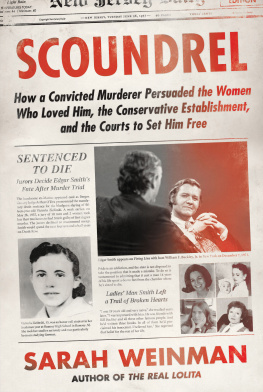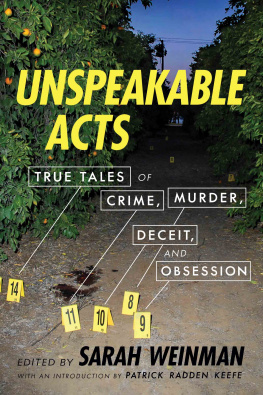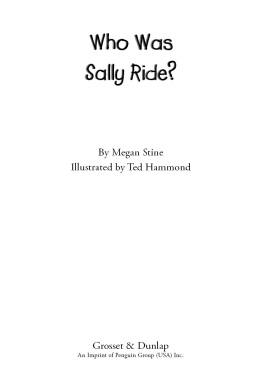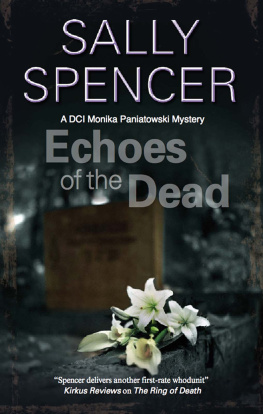For my mother
You have to be an artist and a madman, a creature of infinite melancholy, with a bubble of hot poison in your loins and a super-voluptuous flame permanently aglow in your subtle spine (oh, how you have to cringe and hide!), in order to discern at once, by ineffable signsthe slightly feline outline of a cheekbone, the slenderness of a downy limb, and other indices which despair and shame and tears of tenderness forbid me to tabulatethe little deadly demon among the wholesome children; she stands unrecognized by them and unconscious herself of her fantastic power.
Vladimir Nabokov, Lolita
I want to go home as soon as I can.
Sally Horner, March 21, 1950
Contents
Had I done to Dolly, perhaps, what Frank Lasalle, a fifty-year-old mechanic, had done to eleven-year-old Sally Horner in 1948?
Vladimir Nabokov, Lolita
A couple of years before her life changed course forever, Sally Horner posed for a photograph. Nine years old at the time, she stands in front of the back fence of her house, a thin, leafless tree disappearing into the top right-hand corner of the frame. Tendrils of Sallys hair brush her face and the top shoulder of her coat. She looks straight ahead at the photographer, her sisters husband, trust and love for him evident in her expression. The photo has a ghostly quality, enhanced by the sepia color and the blurred focus.
This wasnt the first photograph of Sally Horner that I saw, and Ive seen a great many more since. But this is the one I think of the most. Because its the only photo where Sally has a childs utter lack of guile, without any idea of what horrors lie ahead. Here was evidence of one future she might have had. Sally didnt have a chance to live that one out.
Florence Sally Horner, age nine.
FLORENCE SALLY HORNER disappeared from Camden, New Jersey, in mid-June 1948, in the company of a man calling himself Frank La Salle. Twenty-one months later, in March 1950, with the help of a concerned neighbor, Sally telephoned her family from San Jose, California, begging for someone to send the FBI to rescue her. Sensational coverage and La Salles hasty guilty plea ensued, and the man spent the remainder of his life in prison.
Sally Horner, however, had only two more years to live. And when she died, in mid-August 1952, news of her death reached Vladimir Nabokov at a critical time in the creation of his novel-in-progressa book he had struggled with, in various forms, for more than a decade, and one that would transform his personal and professional life far beyond his imaginings.
Sally Horners story buttressed the second half of Lolita. Instead of pitching the manuscript into the fireNabokov had come close twice, prevented only by the quick actions of his wife, Vrahe set to finish it, borrowing details from the real-life case as needed. Both Sally Horner and Nabokovs fictional creation Dolores Haze were brunette daughters of widowed mothers, fated to be captives of much older predators for nearly two years.
Lolita, when published, was infamous, then famous, always controversial, always a topic of discussion. It has sold more than sixty million copies worldwide in its sixty-plus years of life. Sally Horner, however, was largely forgotten, except by her immediate family members and close friends. They would not even learn of the connection to Lolita until just a few years ago. A curious reporter had drawn a line between the real girl and the fictional character in the early 1960s, only to be scoffed at by the Nabokovs. Then, around the novels fiftieth anniversary, a well-versed Nabokov scholar explored the link between Lolita and Sally, showing just how deeply Nabokov embedded the true story into his fiction.
But neither of those menthe journalist or the academic thought to look more closely at the brief life of Sally Horner. A life that at first resembled a hardscrabble American childhood, then became something extraordinary, then uplifting, and, last of all, tragic. A life that reverberated through the culture, and irrevocably changed the course of twentieth-century literature.
I TELL CRIME STORIES for a living. That means I read a great deal about, and immerse myself in, bad things happening to people, good or otherwise. Crime stories grapple with what causes people to topple over from sanity to madness, from decency to psychopathy, from love to rage. They ignite within me the twinned sense of obsession and compulsion. If these feelings persist, I know the story is mine to tell.
Some stories, Ive learned over time, work best in short form. Others break loose from the artificial constraints of a magazine article. Without structure I cannot tell the story, but without a sense of emotional investment and mission, I cannot do justice to the people whose lives I attempt to re-create for readers.
Several years ago I stumbled upon what happened to Sally Horner while looking for a new story to tell. It was my habit then, and remains so now, to plumb obscure corners of the Internet for ideas. I gravitate toward the mid-twentieth century because that period is well documented by newspapers, radio, even early television, yet just outside the bounds of memory. Court records still exist, but require extra rounds of effort to uncover. There are people still alive who remember what happened, but few enough that their recollections are on the cusp of vanishing. Here, in that liminal space where the contemporary meets the past, are stories crying out for greater context and understanding.
Sally Horner caught my attention with particular urgency. Here was a young girl, victimized over a twenty-one-month odyssey from New Jersey to California, by an opportunistic child molester. Here was a girl who figured out a way to survive away from home against her will, who acted in ways that baffled her friends and relatives at the time. We better comprehend those means of survival now because of more recent accounts of girls and women in captivity. Here was a girl who survived her ordeal when so many others, snatched away from their lives, do not. Then for her to die so soon after her rescue, her story subsumed by a novel, one of the most iconic, important works of the twentieth century? Sally Horner got under my skin in a way that few stories ever have.
I dug for the details of Sallys life and its connections to Lolita throughout 2014 for a feature published that fall by the Canadian online magazine Hazlitt. Even after chasing down court documents, talking to family members, visiting some of the places she had livedand some of the places where La Salle took herand writing the piece, I knew I wasnt finished with Sally Horner. Or, more accurately, she was not finished with me.
What drove me then and galls me now is that Sallys abduction defined her entire short life. She never had a chance to grow up, pursue a career, marry, have children, grow old, be happy. She never got to build on the fierce intelligence so evident to her best friend that, nearly seven decades later, she spoke to me of Sally not as a peer, but as a mentor. After Sally died, her family rarely mentioned her or what had happened. They didnt speak of her with awe, or pity, or scorn. She was only an absence.
For decades Sallys claim to immortality was as an incidental reference in Lolita, one of the many utterances by the predatory narrator, Humbert Humbert, that allows him to control the narrative and, of course, to control Dolores Haze. Like Lolita, Sally Horner was no little deadly demon among the wholesome children. Both girls, fictional and real, were wholesome children. Contrary to Humbert Humberts assertions, Sally, like Lolita, was no seductress, unconscious herself of her fantastic power.
Next page











